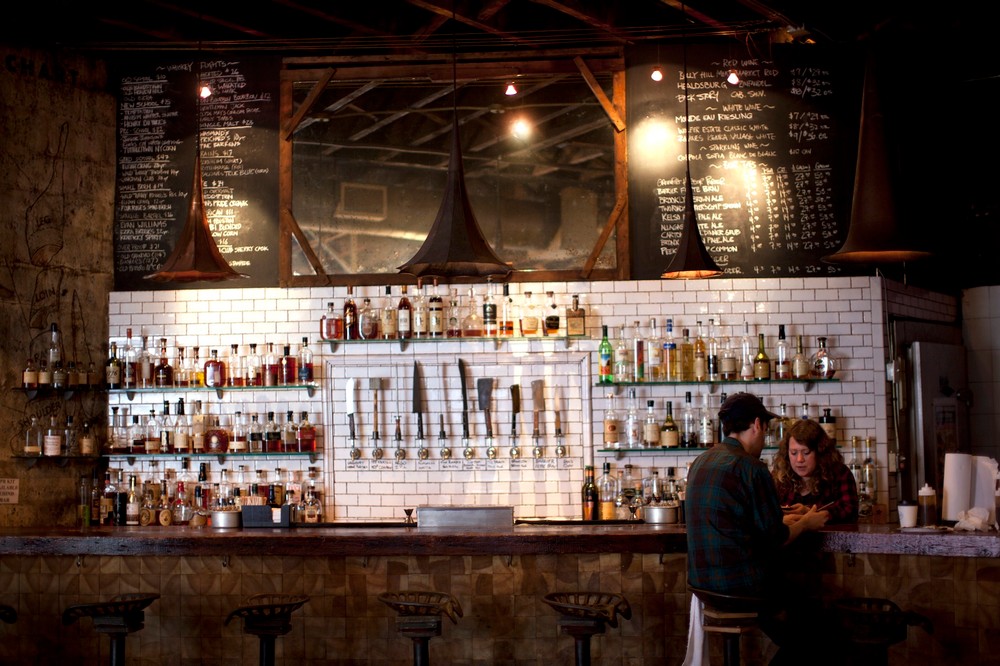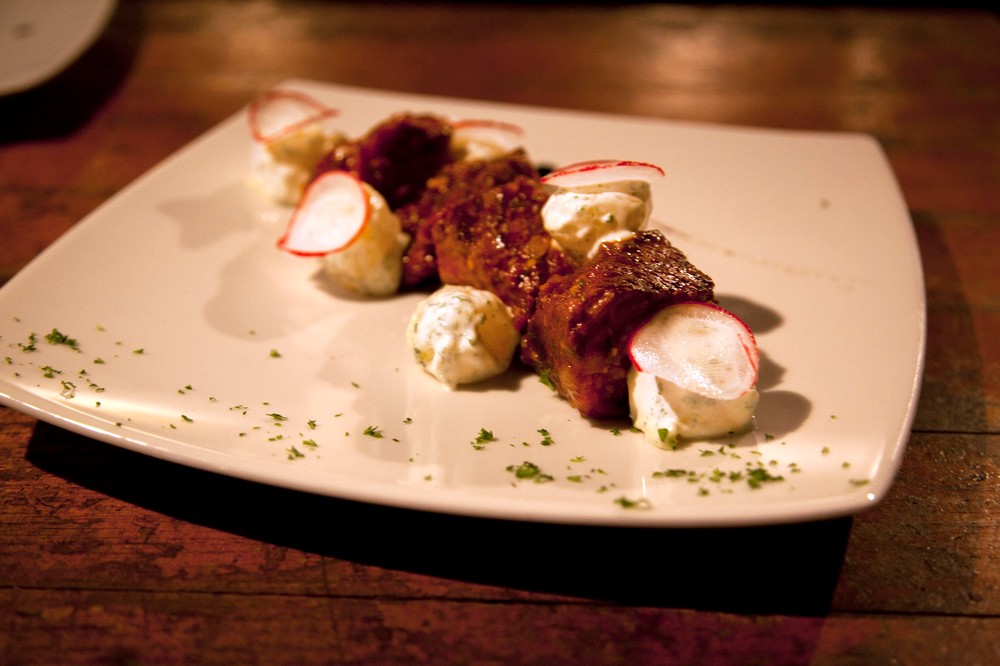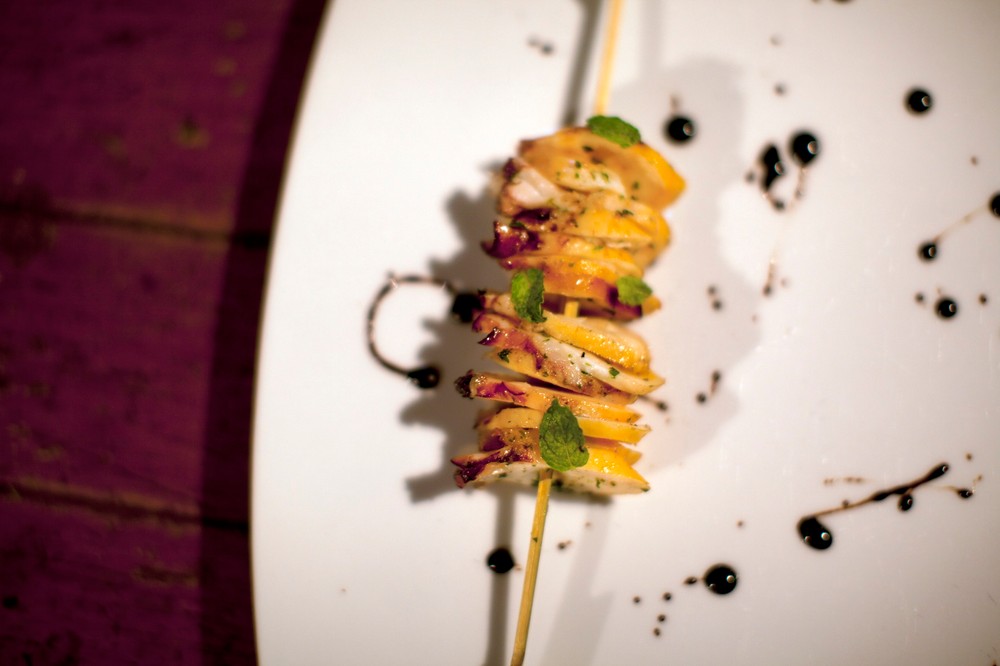This post originally appeared on MUNCHIES in June 2014.
After sitting down at the restaurant Pork in Barcelona, a long menu describing different preparations of pork is set before me. There is charcuterie made from Iberian pigs, various types of dry-aged sausages and chorizos, and slow cooked and grilled pork. Everything is sold by weight. There are also hanging Edison bulbs and the beer, brewed in conjunction with a cult brewer in Liverpool, is served by the jar or by growler. There are butcher knife tap handles in front of white subway tiles. After the waitress explains the menu to me, she says a restaurant in New York was the inspiration.
Videos by VICE
“In Brooklyn?” I ask.
She nods.
“Fette Sau?”
She nods again. I’m not surprised. This is the third time I’ve heard this in a year.

Fette Sau in Brooklyn. All photos by the author.
While I live in North Brooklyn and go to Fette Sau fairly regularly, is this right? Barbecue’s Southern roots and finest pitmasters are a long way from New York, even though the city has grown by leaps and bounds in terms of its barbecue pedigree in recent years. Especially in Brooklyn. It’s almost impossible to walk between Bedford Avenue and the East River without sniffing mesquite smoke. Since Fette Sau opened in 2007, nearly a dozen others have followed, several with pitmasters recruited from Central Texas or Kansas City. There’s the excellent BrisketTown down the street from Fette Sau and Mighty Quinn’s, who slings brisket or pulled pork sandwiches from a stand at Smorgasburg (as well as in a newer sit-down spot in Manhattan). There’s Hometown Bar-B-Que in Red Hook, Fletcher’s in Gowanus, and many others. The décor, for the most part, fits with a wider Brooklyn theme of details like subway tiles, exposed brick walls, Edison light bulbs and lengthy lists of craft beer and small batch bourbons. Brooklyn pitmasters tend to be less traditional than their counterparts in the South. They don’t really follow any single barbecue philosophy and aren’t so focused on beef brisket, like most of Texas tends to be. They may include items like house-cured pastrami or pork ribs or burnt ends. Most use heritage animals—free-range and hormone free—from small family farms within the region.
But now it’s spreading, very quickly and without warning, to every fucking corner of the world. The barbecue being assimilated in places like Colombia, Spain, Panama, Sweden, England, and Japan (and even other parts of the US) is not the killer ‘cue from fabled Texas BBQ cities like Lockhart or Austin. Or even the pork-centric versions with sauce in the southeast. It’s an adapted form of Southern barbecue from Brooklyn. And it all looks like it came straight out of Williamsburg.

BBQ at Pork in Barcelona
“It’s a little frustrating, to be perfectly honest,” said Joe Carroll, who founded Fette Sau. While he’s opened up a second location in Philadelphia and has an eye towards Europe, he’s been contacted to open up branches in the Philippines and even Tel Aviv. “I think they just got fed up with dealing with us and said ‘Fuck it,’ and started doing it on their own.”
“I think we started a wave of a more modern, urban, non-traditional BBQ,” he said. When they launched, Carroll didn’t have a BBQ background and wasn’t interested in following the footsteps of the Carolinas, Memphis, or Texas. “That’s not where my heart was,” he said. He grew up in Northern New Jersey and wanted to create something that relates to the area.
“Ordering by weight is something done in Central Texas, but it is also something they do at New York delis,” he said. “Even our rub has espresso in it. I mean what’s more New York than that?”

Fette Sau’s BBQ
It really doesn’t matter where the hell I go now. There’s a barbecue restaurant that reminds me of North Brooklyn. This doesn’t have to be a bad thing though.
In Panama City I met up with one of town’s top chefs, Mario Castrellón, best known for his restaurant, Maito, which has helped launch a wider Panamanian food revolution. Last year he opened up the BBQ-themed Humo after visiting Fette Sau. His is not the typical BBurg set up, rather the restaurant is set in a cool, canal-style house, though it does have butcher shop art on the walls and a list of whiskies and craft beers. He has created something of his own Panamanian style of barbecue where he smokes brisket with native nance wood and incorporates other native, non-traditional items like octopus or smoked queso fresco on to the menu, which relies on set dishes rather than being sold by weight. You would be pressed to find someone that didn’t enjoy their experience there and it fits perfectly in Panama City, which is already inflected with global influences.

Humo in Panama
“Brooklyn BBQ is more stylish, more loose,” he said. “It lets you break from traditional Texas or Kansas City BBQ. It’s more of a blend of every style, which lets you play around with every recipe rather than following a straight-up traditional recipe.”
Last year I walked into La Fama—which calls itself the first Southern North American BBQ restaurant in Bogota —where the strings of Edison bulbs, picnic table style seating, and exposed brick walls had me second guessing exactly where I was. My mind was officially blown when I learned the restaurant even hired Tom Mylan and Brett Young from cult butcher shop The Meat Hook in Williamsburg to help them set up and create their own style of Colombian BBQ.
“The whole La Fama experience was so weird and awesome,” said Mylan. “We ended up there by chance. They came through the shop and struck up a conversation with Sara, our GM, and one thing lead to another until we were doing a tasting for them on my partner Brent’s deck a few months later—and the next thing we knew, we were on a plane.”
When they arrived, they realized that Colombia had no hickory or post oak or mesquite. There was no kosher salt. There was no brown sugar for the rub. The beef was not even the same species. They had to improvise. For instance, my favorite cut there was the morrillo, which I have definitely not seen in Brooklyn. It’s the hump of the most typical cow in Colombia. They smoke it and sell it by weight along with brisket and pork ribs.
“It was all Bos indicus with the hump and the floppy ears, a tropical breed of cattle called zebu with no intramuscular fat…except in the hump, which is why we chose to use the hump instead of brisket. It was a BBQ guys wet dream: spider-webbed with fat, compact, and honestly the best cut to make beef BBQ with I’ve ever seen.”

Humo in Panama
Few would argue that the barbecue being served in Brooklyn is better than in Texas, so why is a Kings County adaptation that is already a bastardized adaptation the one that is furthering the cause?
“BBQ here [in Brooklyn] can be whatever you want it to be and your BBQ place can look like whatever you want it to look like,” says Mylan. “In the last ten years Brooklyn has really loved taking something with a long tradition elsewhere and fucking with that trope, whether you’re talking the dive bar, soul food, French bistro, Mexican cantina, diner, or BBQ. Results are variable and some things perhaps are better left unmolested, but, through Brooklyn (and NYC in general), a pathological desire to rework these tropes has given the rest of the world carte blanche to fuck with things like BBQ as well, and adapt that type of food to the local diners preferences.”
I wonder what would happen if someone tried to imitate the inimitable Aaron Franklin in Buenos Aires, calling their brisket “Austin-style.” Would there be outrage? Cries of heresy? Maybe it is just that the Brooklyn brand is already so exploited that no one really gives a shit anymore?




